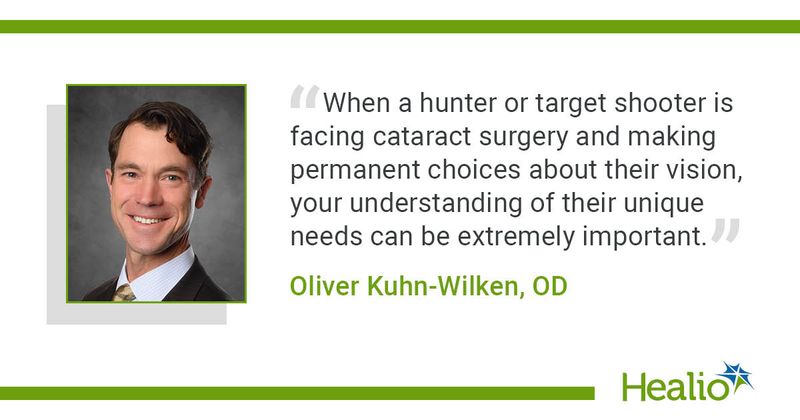BLOG: How to counsel a hunter, target-shooter through cataract surgery
How knowledgeable are you about guns? Do you know the different types of barrel-mounted sights? Do you understand the differences between rifle and shotgun sights?
When a hunter or target-shooter is facing cataract surgery and making permanent choices about their vision, your understanding of their unique needs can be extremely important. Although many optometrists would assume that any hunter would prefer crisp distance vision, there are some situations in which this is not the case.

Consider the case of a shooter who uses iron sights, sometimes called open sights — metal sights that are mounted on the rear and front of the firearm. The shooter visually aligns both sights and their target, but only one of those three planes can be in focus at once. Generally the shooter focuses not on the target, but on the front sight — and that sight requires myopic focus. If they receive cataract surgery with a distance-refractive target, they may not be able to see that front sight well.
Therefore, if your patient uses iron sights, you should have a careful discussion about the most appropriate target. There are several important points to keep in mind: First, the location of the front sight will vary depending on the firearm, from 24 inches with a pistol and a shorter-armed person, to 36 inches or even further with long-barreled rifles. You may need to ask them to conduct careful measurements at home, or even bring their firearm to your office.
Second, the aiming eye does not need to be focused precisely at the plane of the iron sight, only to have a depth of field that includes that sight. Because depth of field is dependent on many complex factors, and varies based on ambient light levels, it can be difficult to determine. For a hunter who is interested in vision at daybreak and dusk, when pupils are larger, the depth of field will generally be 0.50 D to 0.75 D (Sergienko NM).
However, everyone’s depth of field is different, so if your patient does want a slightly myopic target to see their front sight well, a loose lens or contact lens demonstration will be the best way to decide on a precise target.
Third, despite the issues with iron sights, hunters will prize good distance vision, and often the best solution is only a firm understanding that they will still need glasses or a contact lens to see their sights. Realistic expectations are the best defense against disappointment.
Shotguns are often used for shooting small, moving targets, such as skeet and clay pigeons, and have a different setup. There is no rear sight on these shotguns, only a round bead at the far end of the barrel, and the shooter focuses on the target, not the sight. For these shooters, a plano target is appropriate.
Many hunters and target-shooters do not use iron sights, but rely on optical sights such as telescopic sights, reflector (“red dot”) sights, holographic sights and laser sights; these all allow the eye to be focused on the target. For these patients, crisp distance vision is the correct choice.
Some hunters will consider multifocal IOLs, for their ability to provide good vision at distance and near. However, all diffractive multifocal IOLs, and even to some extent the nondiffractive multifocal IOLs, degrade contrast sensitivity — the ability to see in low light conditions. Since daybreak and twilight are important times for hunters, multifocal IOLs should be considered with great caution.
Hunters and target-shooters have unique visual needs, and the more familiar you are with their unique needs, the better you will be able to counsel them when it comes time for cataract surgery.
Reference:
- Sergienko NM, et al. Graefes Arch Clin Exp Ophthalmol. 2008;doi:10.1007/s00417-008-0923-3.
For more information:
Oliver Kuhn-Wilken, OD, is a staff optometrist at Pacific Cataract and Laser Institute’s Tualatin Clinic in Oregon.
Collapse
